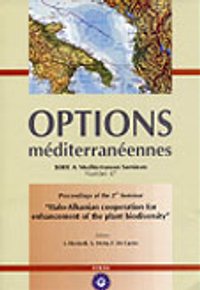| Article précédent | p. 117-126 | Article suivant |
Use of phenotypic distances for the effective genetic variation of some bean populations
Hoxha S., Sulovari H., Papakroni H., Fasllia N.
Eleven bean populations, collected in North Albania, have been studied. They were characterised and estimated by a large number of bio-morphological indicators of the plants and seeds relevant to the bean plant and in accordance with the list of indicators determined by IBPGR. Data were processed according to the method of in-between-groups linkage of the cluster analysis. The grouping was decided by virtue of the Euclidian distance and the Pearson's correlation coefficient. When populations clustered in separate groups they had an extreme phenotypic similarity and therefore they were considered as homologous; if comparing groups to one another there was an extreme dissimilarity they were considered as heterogeneous.
- [ Afficher ]
- [ Télécharger ]
- [ Exporter la citation ]
Vous pouvez télécharger la citation au format :
- [ Imprimer ]
-
Mots-clés
ALBANIE, FEVE, VARIATION GENETIQUECiter cet article
Hoxha S., Sulovari H., Papakroni H., Fasllia N. Use of phenotypic distances for the effective genetic variation of some bean populations. In : Ricciardi L. (ed.), Myrta A. (ed.), De Castro F. (ed.). Italo-Albanian cooperation for the enhancement of plant biodiversity. Bari : CIHEAM, 2001. p. 117-126. (Options Méditerranéennes : Série A. Séminaires Méditerranéens; n. 47). 2. Seminar: Italo-Albanian cooperation for the enhancement of plant biodiversity, 2000/10/26-28, Tirana (Albania). http://om.ciheam.org/om/pdf/a47/02001551.pdf



